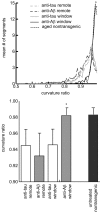Amyloid-beta antibody treatment leads to rapid normalization of plaque-induced neuritic alterations
- PMID: 14645482
- PMCID: PMC6740984
- DOI: 10.1523/JNEUROSCI.23-34-10879.2003
Amyloid-beta antibody treatment leads to rapid normalization of plaque-induced neuritic alterations
Abstract
The accumulation of amyloid-beta into insoluble plaques is a characteristic feature of Alzheimer's disease. Neuronal morphology is distorted by plaques: rather than being essentially straight, they are substantially more curved than those in control tissue, their trajectories become altered, and they are frequently distended or swollen, presumably affecting synaptic transmission. Clearance of plaques by administration of antibodies to amyloid-beta is a promising therapeutic approach to the treatment of Alzheimer's disease, leading to stabilization of dementia by an unknown cellular mechanism. The effect of plaque clearance on plaque-induced neuronal alterations has not been studied previously. Here we show that both plaques and neuritic lesions are reversible in a strikingly short period of time after administration of a single dose of amyloid-beta antibody. Amyloid clearance and recovery of normal neuronal geometries were observed as early as 4 d and lasted at least 32 d after a single treatment. These results demonstrate that, once plaques are cleared, neuronal morphology is self-correcting and that passive antibody treatment has the potential to reverse neuronal damage caused by Alzheimer's disease and, hence, directly impact cognitive decline. Moreover, the rapid normalization of neuritic dystrophy suggests an unexpected degree of plasticity in the adult nervous system.
Figures



References
-
- Bacskai BJ, Kajdasz ST, Christie RH, Carter C, Games D, Seubert P, Schenk D, Hyman BT ( 2001) Imaging of amyloid-beta deposits in brains of living mice permits direct observation of clearance of plaques with immunotherapy. Nat Med 7: 369-372. - PubMed
-
- Campbell MJ, Morrison JH ( 1989) Monoclonal antibody to neurofilament protein (SMI-32) labels a subpopulation of pyramidal neurons in the human and monkey neocortex. J Comp Neurol 282: 191-205. - PubMed
-
- D'Amore JD, Kajdasz ST, McLellan ME, Bacskai BJ, Stern EA, Hyman BT ( 2003) In vivo multiphoton imaging of a transgenic mouse model of Alzheimer disease reveals marked thioflavine-S-associated alterations in neurite trajectories. J Neuropathol Exp Neurol 62: 137-145. - PubMed
-
- Games D, Adams D, Alessandrini R, Barbour R, Berthelette P, Blackwell C, Carr T, Clemens J, Donaldson T, Gillespie F, Guido T, Hagoplan S, Johnson-Wood K, Kahn K, Lee M, Leibowitz P, Lieberburg I, Little S, Masliah E, McConlogue L, et al. ( 1995) Alzheimer-type neuropathology in transgenic mice overexpressing V717F beta-amyloid precursor protein. Nature 373: 523-527. - PubMed
Publication types
MeSH terms
Substances
Grants and funding
LinkOut - more resources
Full Text Sources
Other Literature Sources
Medical
Molecular Biology Databases
